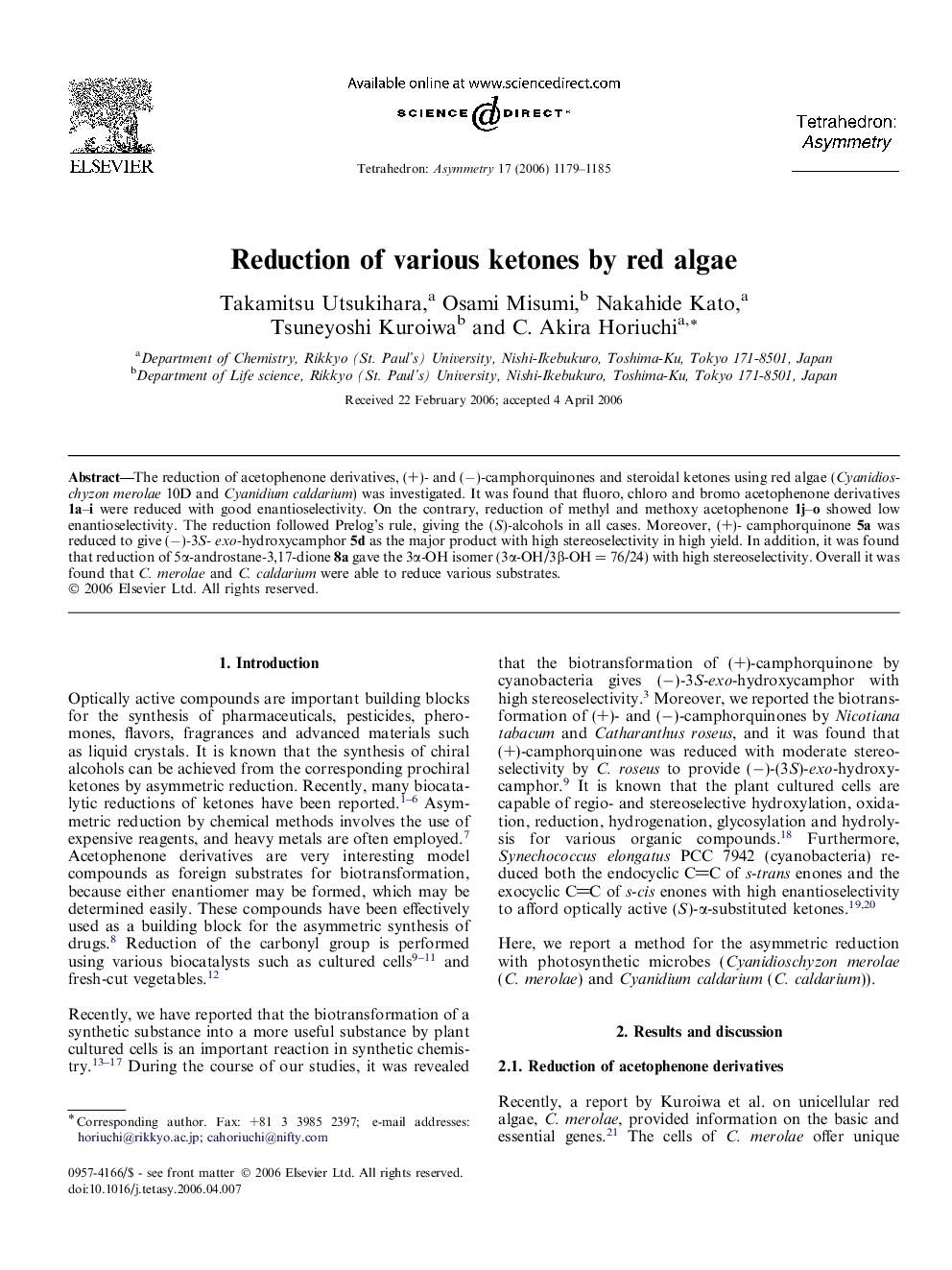| کد مقاله | کد نشریه | سال انتشار | مقاله انگلیسی | نسخه تمام متن |
|---|---|---|---|---|
| 1348899 | 980374 | 2006 | 7 صفحه PDF | دانلود رایگان |

The reduction of acetophenone derivatives, (+)- and (−)-camphorquinones and steroidal ketones using red algae (Cyanidioschyzon merolae 10D and Cyanidium caldarium) was investigated. It was found that fluoro, chloro and bromo acetophenone derivatives 1a–i were reduced with good enantioselectivity. On the contrary, reduction of methyl and methoxy acetophenone 1j–o showed low enantioselectivity. The reduction followed Prelog’s rule, giving the (S)-alcohols in all cases. Moreover, (+)- camphorquinone 5a was reduced to give (−)-3S- exo-hydroxycamphor 5d as the major product with high stereoselectivity in high yield. In addition, it was found that reduction of 5α-androstane-3,17-dione 8a gave the 3α-OH isomer (3α-OH/3β-OH = 76/24) with high stereoselectivity. Overall it was found that C. merolae and C. caldarium were able to reduce various substrates.
Figure optionsDownload as PowerPoint slide
1-(4-Fluorophenyl)ethanolEe = 74%[α]D27 = −40.0 (c 0.9, CHCl3)Source of chirality: biocatalytic asymmetric reductionAbsolute configuration: S
1-(4-Chlorophenyl)ethanolEe = 96%[α]D27 = −45.0 (c 0.9, CHCl3)Source of chirality: biocatalytic asymmetric reductionAbsolute configuration: S
1-(4-Bromophenyl)ethanolEe = 98%[α]D27 = −37.3 (c 1.1, CHCl3)Source of chirality: biocatalytic asymmetric reductionAbsolute configuration: S
1-(4-Methoxyphenyl)ethanolEe = 12%[α]D27 = −4.2 (c 0.9, CHCl3)Source of chirality: biocatalytic asymmetric reductionAbsolute configuration: S
1-(4-Methylphenyl)ethanolEe = 16%[α]D27 = −13.0 (c 0.4, CHCl3)Source of chirality: biocatalytic asymmetric reductionAbsolute configuration: S
1-PhenylethanolEe = 87%[α]D27 = −43.7 (c 0.9, CHCl3)Source of chirality: biocatalytic asymmetric reductionAbsolute configuration: S
1-Phenyl-1-propanolEe = 75%[α]D27 = −38.1 (c 1.0, CHCl3)Source of chirality: biocatalytic asymmetric reductionAbsolute configuration: S
1- Phenyl-1-pentanolEe = 80%[α]D27 = −39.3 (c 0.5, CHCl3)Source of chirality: biocatalytic asymmetric reductionAbsolute configuration: S
1-Pheny1-1-hexanolEe = 59%[α]D27 = −15.6 (c 1.2, CHCl3)Source of chirality: biocatalytic asymmetric reductionAbsolute configuration: S
1-Pheny1-1-heptanolEe = 54%[α]D27 = −17.6 (c 1.2, CHCl3)Source of chirality: biocatalytic asymmetric reductionAbsolute configuration: S
1-Pheny1-1-octanolEe = 37%[α]D27 = −18.3 (c 0.8, CHCl3)Source of chirality: biocatalytic asymmetric reductionAbsolute configuration: S
(−)-3S-exo-Hydroxycamphor[α]D27 = −78.4 (c 1.5, CHCl3)Source of chirality: biocatalytic asymmetric reduction
Journal: Tetrahedron: Asymmetry - Volume 17, Issue 8, 18 April 2006, Pages 1179–1185